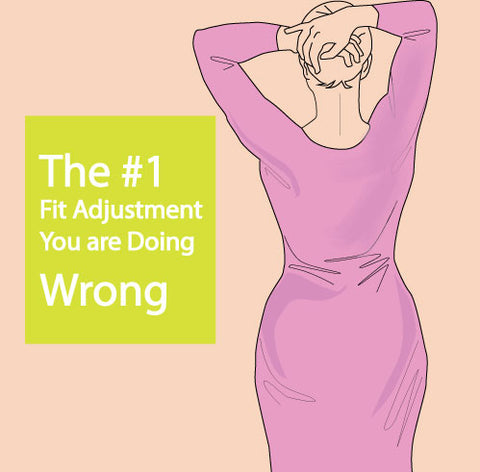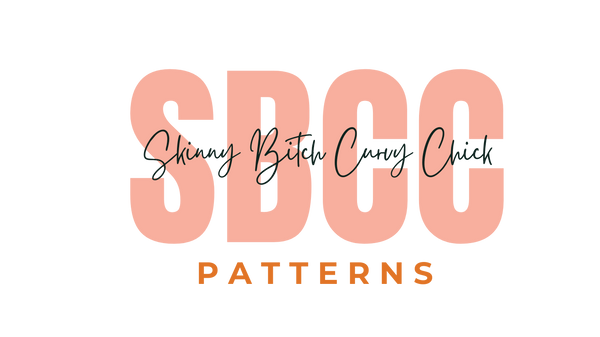
Are you guys ready for this? I am probably going to shock some of you and others will close out the window as soon as they hear what I'm talking about because you have been taught and shown one way so it must be right! I'm sure I'm in for a lot of criticism for this one....
But first, a little backstory to give you my philosophy on alterations.
If you are following along with my series on how home sewing and ready to wear differ, let me start out by saying this: in the garment industry we don't approach alterations the same way as you would if you were altering a pattern to your body. It would be lovely if alterations matched up perfectly to their descriptions in fit books. But the truth of the matter is I don't go into a professional fitting and start talking about FBA's and square shoulder adjustments. Why? Because it just doesn't work that way. Unfortunately no fit revision is usually that straight forward and 99% of the time the revision needed is going to be a combination of tiny adjustments. But here's the kicker- sometimes the real problem is not what you think it is.
What I want to talk about is textbook case of seeing the symptom but not the problem. I'm picking on one specific alteration, but the point I am getting at is that I want you to see your fit issues from a different point of view. So here we go!
Ladies, what I am talking about is the "sway-back" alteration. Yes, you heard me right. I know that it's probably one of your go-to's and you feel confident that you got it down. Yes, there is a lot of fabric back there. Yes, there is a problem. The problem is not your spinal curvature. The pooled fabric at your waist is a symptom. The problem is your butt. Yes, your curves are not playing nice with the shape of the fabric. It doesn't matter how big or how small your hips are, this can be an issue regardless if you are size 20 or a size zero.
Wait, what? How is this possible?
As a pattern maker I find that tightness is a weird and tricky thing to assess. We associate snugness with a good fit. However, there is a very fine hair width of a line between snug and too tight (especially if you are working with knits). Honestly, tightness is the biggest culprit of fitting issues. Tightness is basically the staph virus equivalent for fitting. It's everywhere, but exactly how much is acceptable and preventable is the question. Even on a fitted garment it's possible to be too tight.
When you are pinching out that extra from the center back you are inadvertently creating more room for the hips by way or a sort of "dart".

Why this happens: The fabric pools at your back waist because your hips are squeezed in and are trying to find the widest part of the garment. The pooling of fabric comes from the back hem or skirt pushing upwards to try and find a wider circumference. You may not gain much more width, but every little bit helps.

The sister to the sway-back: Yes, technically this is a different issue, but I feel that it is too closely related not to address. This is the same thing, just vertical instead of horizontal and I don't think we can talk about swayback without throwing this one in as well. This is the appearance of not enough waist shaping at the back- you know when you just want to put a dart in the back to pinch out the extra width.
By doing this you are reducing the waist circumference and inadvertently taking away the room you need to eat lunch. You are also pulling the front side seams to the back (no bueno in my book).

Typically garments without waist darts are the biggest culprit of the sway-back, or sister swayback symptoms. Think about it this way: You are taking a flat piece of fabric and expecting it to conform to your curvy backside. The fabric wants a place to sit, so it will keep riding up until it finds a stable place. It can also appear to be too much fabric at the back waist because your hips are holding the width taut and not allowing the fabric to drape at the waist.
Any skirt without back waist darts is a no-go to me. Unless you have a serious pancake booty, they need to be there. Without them your skirt is going to ride up to your chest. Darts anchor the waist in place not because they create tightness, but rather they create a means of conforming to your curves.
I'm not going to say that you would never need to reduce the back length. There are circumstances, but not as common as I see this swayback alteration being done. Off the top of my head, a pattern that starts out with a good foundation shouldn't need to have more than 3/8" removed from the center back seam in length.
So what is the actual fix?
This depends on the silhouette.
On a sheath dress, blouses, or anything that does not have back waist darts, you are going to need to increase the total hip circumference. To do this, add the amount you need evenly all around. Yes, you really need the width in the back, but this allows you to maintain the integrity of the original pattern without creating additional fit issues.

If you are working on a fitted dress that already has waist darts, it can be a combination of the above and also adding or increasing the back waist dart depths. The trick is to remember to add back to the side seams what you have taken out. Trust me, you are going to want to maintain the circumference so you can breathe and eat. If you feel the waist is too big, take it from the side seams evenly all around. Just like the hip, I want to maintain the integrity of the original pattern, so any reductions/additions need to happen evenly all around.

A few reasons why "sway-back" alterations are problematic
The sway-back alteration essentially shortens the back. The back does not need to be shorter- remember, you need the length to bend over and to sit. But you say that you could just add back to the bottom hem! This is another no bueno for me. I like to keep my hems straight unless it's a purposely curved hem. Back hems should never have to dip down on a pencil shape. If it does this is the #1 symptom the darts are not deep enough and someone "cheated it".

Additionally, the back bodice angle gets wacky: By taking out a wedge from the center back you are essentially changing the angle of the back body. This is going to create a whole new set of issues with the shoulder and neckline. The whole fit becomes warped.
Also, what are you doing to the grainline of your pattern? If you are going about things like the below picture you are asking for trouble. Basically the entire back seam becomes a slight bias cut angle, which allows for stretch, but also creates a great amount of instability.

But what if you have a very curvy back? That's a real thing too, but a swayback is not the resolution for this. If your back is curvy, it is going to be longer, so why would you make it shorter?

The solution is closer to adding shoulder darts to the back neck or shoulders and addressing the length of the front bodice (a post for another day!).
How much do you add?
If you are a numbers person: Review the amount of ease in the pattern. If you chose your size based on your chest circumference, take your chest circumference and subtract it from the finished garment measurement for the chest circumference. This number is the total ease. Now do the same with the hip. The goal is to allow for the same amount of ease for the chest, waist, and hip to maintain closest to the pattern designers fit intent. If you are making a skirt and are finding this to be a problem then the darts are probably not deep enough on the back. Don't be afraid to add a second dart to the back, especially if you are shall we say "voluptuous" in the back. Just remember to add the width you took out for the dart back to the side seam. Don't make the waist too tight. You can still have a shapely garment without sacrificing the width you need.
If you are a visual person: (This is for when the garment has already been sewn together.) Open both left and right side seams from below the waist, stopping at the bottom hem. This will allow you to see how much you need to add based on the gap created once the back waist is smoothed out.
Have I totally blown your fave alteration?
I know this is probably a lot to digest and can appear abstract, but trust me on this one. It's much easier to release/add to the hips than it is to sacrifice the rest of the fit. I would never in a million- bajillion years do a sway-back adjustment for mass production. I might do a variation of warping the back panel, but it is very controlled and I take it on a case by case basis in the rarest of circumstances. But most of the time, I am either adding back waist darts or bumping up the hip circumference to alleviate the pooling.
However, I'm not opposed to pinching out small amounts that are closer to 3/8" or 1CM. If this is going to be the easiest- go for it. This is not going to be too disruptive to the fit and if it makes sense, then do it. But if the numbers exceed this, then consider the above.
But let's go back to the main point I am trying to get at: next time you think you need to go one way, rethink the direction and ask yourself is it a symptom or the problem?


50 comments
Hello! I’m decent at following a pattern, but getting a good fit is so challenging. I recently made the Jenny pants by Closet Core. They are VERY high waisted. I have the fabric pooling above my butt. It doesn’t seem intuitive that the problem is my hip width… my hips have always been narrow compared to my other measurements. I saw that one potential solution is to make the butt darts bigger/deeper. Then, I guess I’d have to remove a little from the center front seam to make sure the side seams don’t get pulled back? What do you think? I know for sure I have lumbar lordosis. 🙂
Boa noite!
É ótimo a explicação e clara.
Gostei muito…
Just so you know, this has been a very helpful blog post and I’ve made strides in pattern drafting since reading. Thanks!
How much more to add to the waist dart my back is deep in is it that I’m to add more to the back hem when more is add to the waist dart on jacket and dress wish you could do a video
I don’t think I’m convinced. The sway back generally should be taken above the waist not at the waist. And the dart being made is the excess of fabric sitting above the waist. If one is pulling fabric from below then, yes it is wrong and will pull the skirt up. I do this all the time and it fixes the excess fabric sitting above my waist. Thanks